CivCity: Rome Review
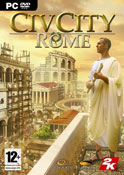
| Developer: | FireFly Studios |
| Publisher: | 2K Games |
| Genre: | City Building RTS |
| Platform: | PC |
| Official Site: | http://www.fireflyworlds.com/ccr_index.php |
| Release Date: | July 26th, 2006 (UK) |
| Reviewer: | Craig Dudley (Mani) |
| Buy now at Amazon.co.uk | |
It hasn't been very long since I finished playing Glory of the Roman Empire - a game which I enjoyed immensely - and here we go again with a second Roman city building RTS in the space of as many months. CivCity: Rome as the name suggests takes some inspiration from the Civilization series, that inspiration is probably something along the lines of the following question: what if while playing Civilization you could micro-manage one of your cities? The result is a solid strategy title that while being highly addictive is a little rough round the edges.
While reviewing Glory of the Roman Empire I waxed lyrical about its stunningly simple and intuitive user interface and while I can't quite do the same about CivCity: Rome, it still is very good. Constructing a building is as simple as selecting its class from the docked left menu, then clicking its image in the menu that pops out, a fine way of doing things but it does use up a fair bit of the screen. However, most buildings do not take time or in-game materials to build, they simply appear, this picks up the pace no end as you can in theory fill up the map with your constructions in seconds, providing you have enough money.
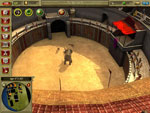
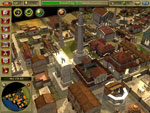
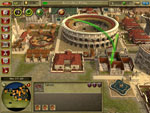
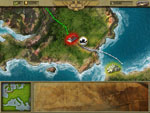
I can't finish talking about the interface without discussing the engine and its camera angles, the game itself runs very well on my mid-range PC and only suffers slowdowns in the very largest of cities, I do however have one rather large bone to pick. I simply don't think you can zoom out far enough or get a high enough angle to see behind buildings without spinning the camera. I can understand why the camera is limited in such ways as it reduces the amount of buildings which must be drawn and therefore improves overall performance but I found it very limiting and frustrating having to rotate the camera so much. And that is unfortunately only aggravated by a mouse pointer bug, it's particularly obvious when you're trying to delete structures, the mouse doesn't seem to register on the right piece of ground, this can be nasty when you accidently delete the Coliseum that you've just built when I took so long to complete. The only way to reduce the issue is the zoom all the way in. It does however get much worse in the higher resolutions; you simply have to take great care when deleting anything.
Zooming in though gives you lot's of detail, get really close to buildings and their roofs will disappear allowing you to see inside and watch your citizens going about their daily routines, highlighting a building will show you where it's inhabitants or works are currently, underneath the big green arrows you'll see in some of the screenshots. From here you can also get encyclopaedic information about that building or indeed some facets of it, while I'm sure most people won't spend too much time checking that out, it's a very worthwhile addition for the rest of us and not long winded at all.
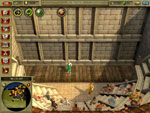
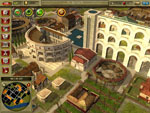
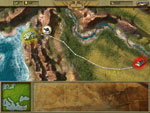
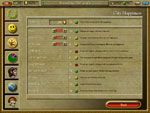
As already stated; all buildings are purchased with cash and not materials. This money must be raised through taxes and trade, in order to raise tax you must build and your citizens must occupy houses. All houses start as shacks and can grow all the way up to palaces if they are in range of all the correct supplies and as they grow, so does the revenue you collect through tax. However each house has a range, an area in which the occupants will travel to collect the goods they require. Again, as the house grows, so does this range. A useful tip here is to remember that houses can be moved and that it's cheap to move them, if you have a house that's development is stuck because the occupant can't find any bread, it's perhaps not necessary to build more bakeries or food stores closer to the house when you can just move the house closer to a bakers for a while, you can always move it back later by which time it may well have a greater range and the occupants may be able to find more bread on their own.
As you might expect, as houses grow in stature, they also grow in size and you should plan your city accordingly, space does come at a premium on some maps, particularly as some buildings can be absolutely massive. The largest being the Circus Maximus - think chariot race in Ben Hur - which is actually very difficult to place as even zoomed all the way out you can't see it all on screen at once!
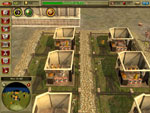
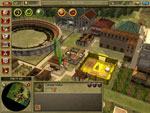
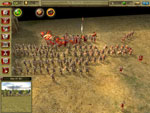
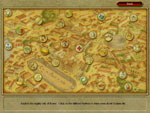
Once your settlement is established you'll need to keep a careful eye on city happiness, should your citizens become too unhappy they will start to leave and your buildings will cease to function, in extreme cases your houses will end up unoccupied which will have adverse effects on your tax revenues. Many things have an effect on city happiness, from the rate of tax you are charging, the level of rations, level of technology and civilization in your city to name but a few. Generally it's a balancing act, early in the game allowing city happiness to fall so people leave and unemployment drops is a useful strategy until you have enough money to lower taxes appreciably.
Trade is essential in CivCity: Rome, in several missions you simply don't have many of the required supplies, bringing up the empire map will show the region in which your city resides and any other cities you may be able to trade with or fight against. Trade routes can be both overland and by sea but both will have to be purchased, optionally roads can be built on overland routes to speed up your mule trains. Attacking enemy armies are also visible on the empire map and can be intercepted by one of your own armies here if you wish. In this case the computer uses an algorithm to decide which army wins based on number and quality of troops, this is fine if you're in a hurry but is essentially a bit dull. The alternative is to let you enemies arrive in your city and try to intercept them before they can start destroying your buildings.
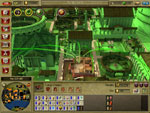
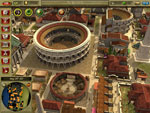
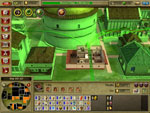
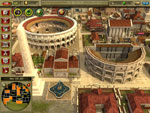
In the military missions you can build up to three legions each comprising of three cohorts or squads of twenty five men, each squad can be either sword bearing Legionaries or javelin throwing Velites. You can reconfigure them if you wish but in all honesty combat and military options are quite simplistic, the later missions do allow the construction of walls and gates which make things a little more interesting though.
Throughout the game you can spend money on researching new technologies for you city and its inhabitants, from making roads easier to walk on and crops grow better all the way to fine arts, each new technology can help quite a bit. However in most scenarios you only really need research a few specific items, you simply have to finish the earlier items in the tech tree to reach what you need. In my opinion this length of tech tree works better in multiplayer games to allow differing strategies, it does have the habit of feeling a little redundant in most missions.
As with most game of this type there is no multiplayer so it's basically campaign mode with five or six peaceful missions and a similar number of military missions to accomplish then a small number of scenarios to keep you playing for a while. While this sounds short, it's not really, each of the dozen or so missions can take many hours to complete and once we throw in the map editor then we're not really getting a short game. The missions themselves do offer a relatively varied set of challenges and the avatars and characters that present the missions are all acted well which usually sets the scene nicely however replay value isn't all that high to be completely honest.
Summary
While there is more depth to CivCity: Rome it's not going to score that much higher than Glory of the Roman Empire, it's a slightly better strategy game for the most part and is more polished but it does have a number of slightly annoying issues, not least the inaccurate mouse, particularly when deleting things. Inevitably when the two games have such similar subject matters you're going to like some elements of both, I'd like to graft Glory's user interface and camera angles into CivCity: Rome for starters. Having said that, CivCity: Rome has kept me entertained for many hours, should you have any sort of liking for city builders, it will probably entertain you too.
Good stuff
- Deep and addictive strategy title
- Good voice acting
- Encyclopaedia
Not so good stuff
- Poor camera angle
- Mouse bugs
- Very difficult to place some buildings accurately due to their on-screen size
- Simplistic military element
Things You Should Buy Just After You Move Into New House
Packers and Movers Chennai Are the Best At Such An Affordable Price
Guide For Packing Up The Master Bedroom In An Organized Way
Girls Are You Packing For College? Then You Need To Read These Tips First.